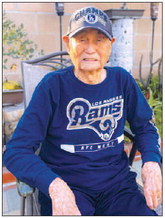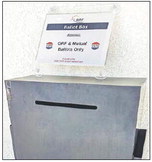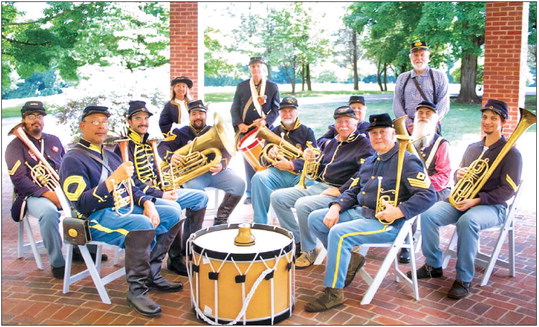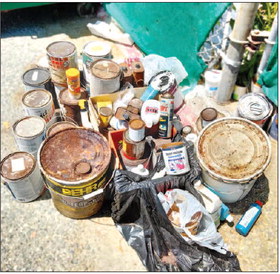Celebrating Centenarian George Mayeda


This is one story in an occasional series profiling some of LW’s most long-lived residents, those who have reached the enviable age of 100 years or more. The series is running in connection with the Golden Age Foundation centenarian event held April 20. In most cases, a family member or friend has written the stories.
by Kyle Sadler
special to the LW Weekly
George Mayeda will celebrate his 100th birthday on June 13. He was born in Riverside, California, in 1922, one of five siblings. His father and mother had come to California from Japan. His father worked as a foreman in a packinghouse for produce and in a pool hall in the offseason.
At 5 or 6 years old, he and his older brother Tom went to Japan for several years to live with their uncle while the family focused on work, gardening in the Hollywood area and taking care of their siblings Tane and Sam.
When the brothers returned, their new brother Shoji had been born, and the family had relocated to San Gabriel. Here, they started a collection of businesses, including a gas station, pool hall and grocery store.
When the U.S. entered into World War II, Franklin D. Roosevelt’s Executive Order 9066 ordered the incarceration of Japanese American citizens living along the West Coast. Like 120,000 people of Japanese descent, George and his family were forcibly relocated and imprisoned in internment camps.
Most families had to leave all of their belongings behind or sell them for dirt cheap. Fortunately, a family the Mayedas were acquainted with held their belongings and property for them and rented their businesses while they were in the camps.
Tulare Race Track near the Sequoia National Forest was their first destination. The track had been converted into a processing center and internment camp, with the horse stalls crudely converted into sleeping quarters.
They later found themselves at the Gila River Relocation Camp in the Arizona desert, where they would stay for the next several years. The center was built on the Gila River Indian Reservation. Two internment facilities, Canal and Butte camps, were established there. There were rows of military-style barracks, or large wooden shacks, set up, and the grounds were fenced in and patrolled by armed guards. George remembers they had to hang sheets to partition different families’ living quarters. The peak population was over 13,000 in these camps, though they were designed for no more than 10,000.
George did a number of things for work while at Gila. He tended cattle and learned how to ride a horse, fixed fences, washed dishes and delivered ice to the mess halls. (“The good, clear ice,” George said, “was saved for their friends.”) He worked in the post office, and he and his friends would occasionally sneak into town to go to the movies in the back of the postal truck. Seasonally, he worked on a farm outside of the camp, harvesting and separating sugar beans. On the nearby railway, he hammered nails, sleeping on the tracks some nights.
Also while in Gila, he met his future wife, Fumi. She was close friends with his younger sister Tane.
During the war, his older brother Tom was in the Army as an interpreter based in Korea. George himself was nearly drafted and even had his physical examination, but the war ended shortly beforehand.
Finally released from camp, George and his family moved back to San Gabriel, where they were able to resume their business. Members of Fumi’s family had moved to Chicago as the war was ending, but she eventually came to San Gabriel to be with George. They married in 1946 and had their own house built in the area.
George and his brothers Tom and Shoji began working as gardeners. They joined a bonsai organization taught by famed bonsai master John Naka. George remembers one of his bonsai being featured in one of Naka’s magazines. Sometimes, in the early morning, they would travel to the mountains and dig for trees to use in their own personal bonsai projects.
After the birth of their daughters Hannah and Jan, Fumi, who had been cleaning houses, went to night school. She went on to work for the Bell Telephone Company key punching and, later, as a secretary. Eventually, she quit working to take care of their first grandchild, Heather. George continued his work as a gardener to a loyal clientele in the San Gabriel Valley until retiring at the age of 85. Fumi and George lived with their daughter Hannah for several years before moving into Leisure World.
Recreationally, George’s life has been filled with fishing trips and bowling leagues. There’s been trips to the local swap meet, the Santa Anita Race Track to bet on the horses and Las Vegas with the family. Other highlights are the Christmas potluck and gift exchange with all the Mayedas (with so much food), Fourth of July fireworks in the street and kicking people’s butts at pool.
In 2018, Fumi passed away. George likes to keep fresh-cut flowers from their garden for her in one of the blue vases she collected.
“I think I was pretty lucky to marry her. She was a really smart woman,” he said.
On weekends, George visits with his daughters, wins rounds of pool at Jan and Tim Sadler’s place, or takes a short walk to visit his daughter Hannah, who now lives in Leisure World.
Most days, though, he can be found watching his favorite game shows and westerns, or rooting for the Dodgers. He also enjoys visits from Heather, Jorge and great-grandson Noah Valerio, who introduced him to watching NASCAR races. Their dog Sofie is always excited to see Papa, too.
He’ll often check on the upkeep of the plants in his garden while out for his daily walk and assist with grafting the plumeria plant to coax out different colored flowers.
His grandson, Kyle Sadler, has been his caregiver since the pandemic and continues to keep him happy with kimchi grilled cheese sandwiches or bowls of takeout pho.
“I’ve had a pretty good life so far,” said George, and we wish him many more years to come.





